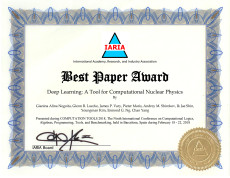Berkeley Lab Researchers Co-Author IARIA’s Best Paper
September 21, 2018
By Linda Vu
Contact: cscomms@lbl.gov
A paper co-authored by Berkeley Lab’s Esmond Ng and Chao Yang won best paper at this year’s International Academy, Research, and Industry Association’s (IARIA’s) Computation Tools 2018 conference in Barcelona, Spain. The paper, Deep Learning: A Tool for Computational Nuclear Physics, describes how feed-forward artificial neural networks can be used to predict the properties of atomic nuclei.
“Nuclei are complicated quantum many-body systems, and their inter-nucleon interactions are not known precisely. One of the major goals of nuclear theory is to be able to predict the structure and reactions of these subatomic particles using the underlying theory of strong interactions, also known as quantum chromodynamics (QCD),” said Gianina Alina Negoita, a graduate student in Iowa State University’s Department of Computer Science and first author on the paper. This work is part of her Ph.D. thesis.
Currently, researchers capture nuclear properties by running first-principle models on supercomputers, which works fine for smaller systems, but can become unwieldy for larger systems. Because artificial neural networks learn from a set of examples and can effectively map non-linear problems, Negoita notes that this approach can identify solutions where the first-principle methods cannot or when the problem becomes too computationally expensive to compute.
“Quantum many-particle physics is well-known as a computationally hard problem. Even with the best supercomputers, you can only do it in some approximate way,” said James Vary, professor of nuclear science at Iowa State University and a co-author on the paper. “An infinite computer that doesn’t exist may be able to get an exact answer about the mass and size of certain nuclear systems via first-principal approaches, or we can have artificial neural networks make fairly accurate projections based on the accumulated knowledge so far.”
In the paper, the team describes a proof of concept where they designed artificial neural networks that successfully predicted the size and ground state energy of lithum-6 nuclei. Based on their findings, they concluded that neural networks are successful for calculating the properties of nuclei that are too big for direct many-body calculations. In future work, the team hopes to investigate more lithium isotopes with artificial neural networks like lithium-7, lithium-8, and lithium-9 as well as heavier systems.
In addition to Negoita, Ng, Vary, and Yang, other co-authors on this paper include: Glenn R. Luecke,and Pieter Maris of Iowa State University; Andrey Shirokov of Moscow State University; as well as, Ik Jae Shin and Youngman Kim of the Institute for Basic Science in Daejeon, Korea.
The computations for this work were done at the National Energy Research Scientific Computing Center (NERSC), a Department of Energy (DOE) user facility. The research was supported in part by funding from DOE's Scientific Discovery through Advanced Computing (SciDAC) NUCLEI project, and by Professor Glenn R. Luecke's funding at Iowa State University.
About Computing Sciences at Berkeley Lab
High performance computing plays a critical role in scientific discovery. Researchers increasingly rely on advances in computer science, mathematics, computational science, data science, and large-scale computing and networking to increase our understanding of ourselves, our planet, and our universe. Berkeley Lab’s Computing Sciences Area researches, develops, and deploys new foundations, tools, and technologies to meet these needs and to advance research across a broad range of scientific disciplines.







 Instagram
Instagram YouTube
YouTube